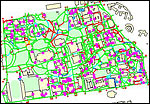UC Berkeley Press Release
Mobility around UC Berkeley for disabled students to improve as result of cooperative effort
BERKELEY – Physical barriers that may have hampered access to the University of California, Berkeley, campus for students with mobility or vision disabilities will be removed and improvements will made to campus grounds and buildings when a proposed settlement of a class action lawsuit is finalized later this spring.
 Disability inclusion at UC Berkeley: A history |
The multi-year undertaking by the campus will include wide ranging physical changes, improved on-campus transportation options and a new procedure for students to get quick resolution to access problems, among other actions. Some of the improvements are already underway.
UC Berkeley is a historic leader in higher education in providing innovative and progressive accommodations to its students with disabilities, but the campus's hilly terrain and old buildings have created difficult challenges for the campus as it has sought to address the mobility needs of disabled students.
"This is an outstanding opportunity to take a long-term, comprehensive approach to upgrading physical access," said Sarah Hawthorne, assistant provost of equity standards and compliance. "This agreement underscores UC Berkeley's longstanding commitment to ensure that all students benefit fully from their experience here."
The agreement settles a class action lawsuit, Gustafson vs. Regents of the University of California. The named plaintiff in the case, Kaaryn Gustafson, was a doctoral and law student at UC Berkeley when the case was originally filed in federal court in 1997.
Instead of adversarial litigation, the parties agreed to a voluntary cooperative process. To settle the case, a jointly agreed upon panel of experts undertook an extensive survey of the campus and issued a detailed set of recommendations. The comprehensive settlement agreement was then negotiated by the parties. The proposed settlement was announced this week.
"The cooperative nature of the process has been a great success in many ways," said Jeffrey A. Blair, the UC Office of the General Counsel attorney who handled the matter. "The university was able to incorporate ideas and recommendations from students and disability advocates from the community in a non-adversarial, cooperative manner. The university conservatively saved several million dollars in attorneys' fees and more in litigations expenses, and has forged a more collegial relationship with the disability community that will benefit both sides for years to come."
The group of people addressed in the class action suit are UC Berkeley students with mobility and visual disabilities. Currently, there are about 100 such students enrolled on campus. A final approval hearing is set for March 23 in federal district court in San Francisco.
The settlement addresses two aspects to campus access: mobility involving the physical premises, such as paths of travel between buildings and barriers that may limit access inside buildings, and program and activities access, such as the ability to participate in class trips and attend cultural and athletic events.
Hawthorne, who will provide campus-wide leadership and work with the campus's Disabled Students Program, said that while the suit was focused on students, many of the improvements such as signage, paths through campus, and building evacuation and safety practices will benefit campus staff, visitors and others for whom mobility and visibility access are concerns.
Implementation of the settlement is already underway and is expected to span several years, as the campus seeks to make improvements in the most cost-effective way, such as folding in access improvements as older buildings are modernized.
A 35-point summary of the settlement is available online at: http://equity.chance.berkeley.edu (Gustafson links at lower left).

